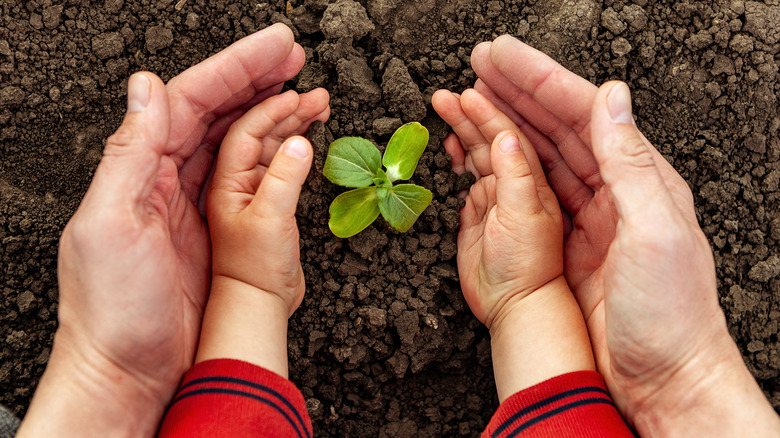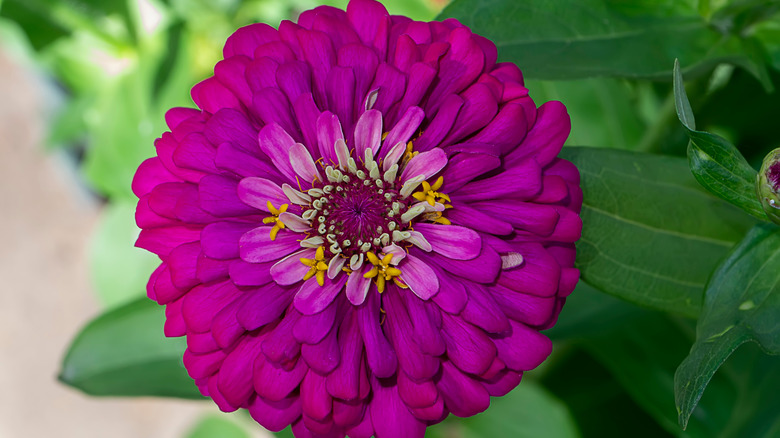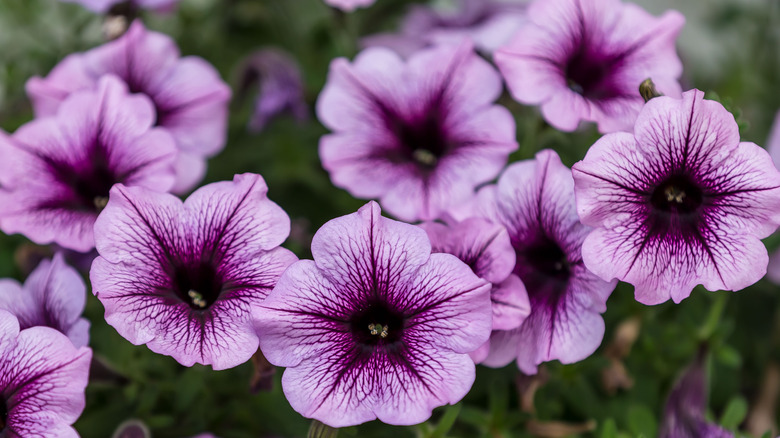The 5 Best Plants For Your Kids To Grow
Teaching gardening to your kids is a fun way to encourage healthy eating, introduce them to science, and build their confidence, explains Montessori Nature. It is a great way to instill in them a sense of responsibility to the earth, amplify their memory, teach them about virtues such as patience, and enhance their focus in a world where many of these qualities are missing. Moreover, gardening with your kids is fun and therapeutic as it fosters bonding.
You may prefer to teach them about indoor gardening before taking the classes outdoors. However, regardless of the approach, one thing you need to be extra careful about is the type of plant you introduce to children. As explained by The Bump, kids should not be allowed to handle poisonous plants such as pothos, oleander, mistletoe, fox glove, holly, and peace lily (not so peaceful after all). Similarly, plants that are difficult to grow won't give them the best learning experience. To that end, we have created a list of five non-toxic and easy-to-grow plants for your kids.
Nasturtium
Rated by Fun Flower Facts as the perfect plant for beginner gardeners, the nasturtium (tropaeolum spp.) is a brightly colored annual flowering plant native to Peru. It is characterized by umbrella-shaped leaves, long stems, and edible single or double flowers in shades of orange, yellow, and red. The peppery-flavored flower, which packs iron and vitamin C, was said to be an alternative to pepper during World War 2. Meanwhile, the seeds are a substitute for capers. Dave's Garden asserts that growing nasturtium in your vegetable garden could also help to keep pests away.
To teach kids how to plant nasturtium seeds, Almanac instructs them to dig 1-inch holes in well-drained soil in full sunlight or partial shade. Make sure the holes are 10 inches to 12 inches apart to give enough room for crawling. Also, let the kids know that the best time to grow nasturtiums is 2 to 4 weeks before spring for indoor planting, or 1 to 2 weeks before spring for an outdoor garden. After planting it, nasturtium should be regularly watered, especially in summer when the heat waves can seriously deter growth.
Hens and chicks
According to the North Carolina State Extension, hens and chicks (sempervivum tectorum) is the name of a southern European plant with concentric rings of succulent, fleshy leaves that form a geometric rosette. Also known as house leek, this rose-like plant is best grown in sharp, well-drained (preferably gravely) soil in a hot, sunny environment. Kids will find its growth process fun to observe: a germinated seed first forms what is called a hen. This is the main rosette, which is surrounded by smaller rosettes called chicks.
Plant Addicts advise that hens and chicks should be planted 2 feet into the soil in early or late spring, and each planted seed should be separated from other plants that require a lot of water to avoid drowning. Since hens and chicks make perfect container plants, you can either grow them indoors or outdoors in the backyard and put your kid in charge of the weekly watering. As they grow, bloom, and eventually die, you can also teach your kids how to uproot and dispose of dead plants.
Zinnias
Named by German botanist Johann Gottfried Zinn, Zinnia plants are fast-growing plants with colorful flowers and rough or smooth leaves that can either be lance-shaped or arrow-shaped, Wikifarmer writes. The flowers are often bright orange, lilac, pink, yellow, white, purple, or red in color, which attracts a host of pollinators such as butterflies — another exciting aspect for young children.
Per GrowVeg, zinnias do not thrive well in low temperatures and, as such, should be planted in full sunlight on a site with good drainage in late spring when the soil is warm. To grow zinnias, Growing In The Garden writes, plant the seeds in a tray of fertilized soil indoors from February to May and then transplant them outdoors with a spacing of 6 inches to 18 inches between March and June. This gives kids the opportunity to learn about soil fertilization, indoor and outdoor planting, and transplantation.
Petunia
Children will love to experience every stage of the growth of petunia, a hybrid annual plant existing in 35 species. According to Ten Random Facts, it is an ornamental plant with bi-colored flowers that attract pollinators. A typical petunia can grow as tall as 4 feet while its flowers can spread as wide as 4 inches. Burpee also asserts that petunias are fairly easy to grow, preferably in well-drained fertile soil in a sunny location.
To grow potted petunias in winter, sow the seeds at the center of the pot in groups of two and water them immediately, explains Alkarty. It's preferable to mix your soil with well-manipulated manure or any other organic compost in a ratio of 2 to 1. Also, when petunia plants start to sprout (which happens within 8 or 10 days of planting), shelter them from excessive sunlight, water them every day (especially in summer), and keep an eye out for infections that may be caused by fungi and insects. When watering petunias in bloom (flowers should start popping out within 35 to 50 days of planting), introduce the water over the plant in form of a shower.
Purple coneflower
Purple coneflower (echinacea purpurea) is a herbaceous perennial plant with large purple-colored, daisy-shaped flowers. It thrives in full sun or partial shade and takes 10 to 20 days to germinate, according to Michigan State University. It is a native of the eastern United States, and, just like hens and chicks plants, is best grown in sharp and rocky, well-draining soil. The purple coneflower is adaptive to the heatwaves of summer and has the ability to survive on its own during times of drought.
According to Planet Natural, the planting site should be infused with animal manure or organic compost to ensure steady, healthy growth. With the soil prepared, bury your purple coneflower seeds 1/2 inch deep and water them frequently. This type of plant can become a target for insects, so it would offer the opportunity to teach children about pest control. It would also be nice to engage the kids in weeding to keep your purple coneflower plants looking their best.





